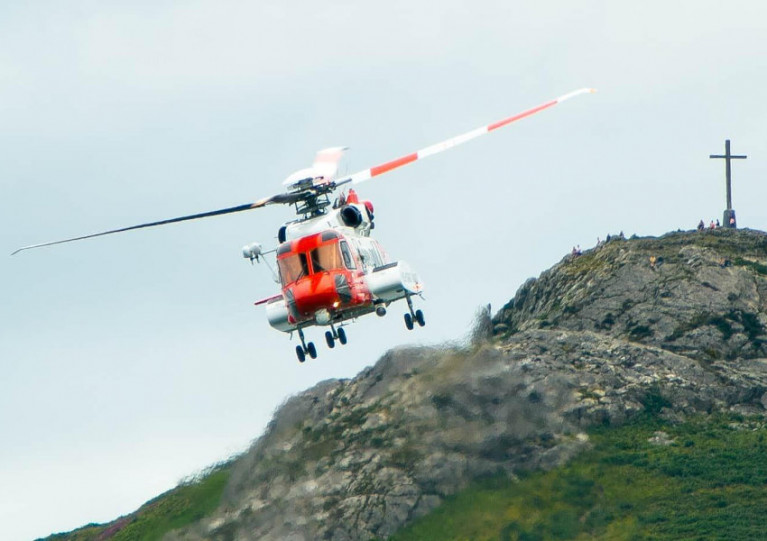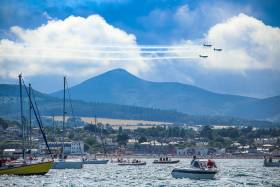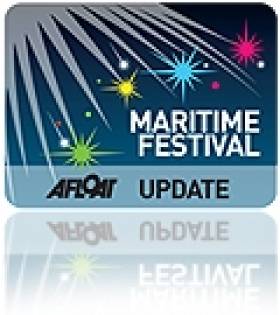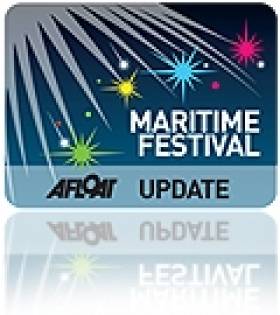Displaying items by tag: Bray Air Display
In the absence of this year’s Bray Air Display due to the coronavirus pandemic, the Irish Coast Guard’s Dublin-based helicopter Rescue 116 conducted a special fly-past to pay tribute to Ireland’s frontline healthcare workers.
The Sikorsky S92 helicopter took to the skies over the Co Wicklow town at 3pm yesterday, Saturday 25 July, on the same afternoon it flew to the rescue of a family of four stranded by the tide at Sandymount.
Rob Tatten, general operations manager of CHC Ireland, which operates the coastguard’s SAR helicopter service, was in attendance to make small presentation to Mr Paul Reid, chief executive of the HSE, and spoke before the event.
He said: “CHC, who operates the helicopter search and rescue contract on behalf of the Irish Coast Guard, has been taking part in the Bray Air Display every year. However due to the pandemic that wasn’t possible this year.
“But with the organisers of the show we said could we do something to recognise the phenomenal work of our fellow frontline healthcare workers, who like us continue to work 24/7, 365 days a year.
“So today, Rescue 116, while out training, will do a fly-past to thank those workers while we also make a short presentation to Paul Reid and other frontline workers to say thank you on behalf of CHC, the Irish Coast Guard, the aviation community and Bray Air Display.”
Bray Air Show Draws The Boats – Fleet of 200 Gather For Spectacular Display off Wicklow Coast
An estimated 1,000 boaters in a fleet of 200 boats gathered off the County Wicklow coast this afternoon for a spectacular edition of the Bray Air Show.
A selection of pleasure craft from small fishing boats and RIBs right up to to 60–foot yachts were part of the combined armada that were treated to some of the best views for over an hour of spectacular aerial displays at the annual weekend event.
Visiting aircraft gave some heart–stopping displays for shoreside crowds of up to 90,000 on Bray Promenade but the best of all was dished up to those afloat with dizzying displays directly over boaters off Bray Head.
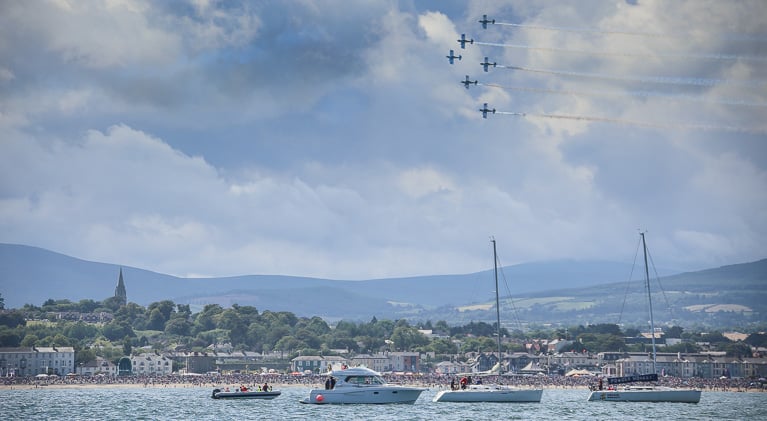 Ringside seat – boaters got great views off the Bray coast
Ringside seat – boaters got great views off the Bray coast
Headlining today was an F-18 jet from the Spanish air force demonstrating the very best of aerobatic skill and performance. The Royal Jordanian Falcons also wowed the crowd flying Extra-300 L aerobatic aircraft. A little more sedate but equally special were displays of a 74–year old Catalina Flying Boat and a beautiful vintage Aer Lingus DC-3 aircraft resplendent in 1940s livery. There was plenty of other Irish talent on display with Eddie Goggins, aka ‘The Flying Dentist’, the Irish Air Corps and the Irish Historic Flight Foundation flying Stearman and Chipmunk aircraft. The Irish Coast Guard also demonstrated a safe water rescue. A fitting tribute was paid to the courageous crew of the R116 who tragically lost their lives earlier this year.
Performances by international acts included the ‘Swedish Air Force Historic Flight’ team flying Viggen jets, a British Spitfire and a Seafire and a MiG aircraft as well as a pair of ‘Vampires’ representing Norway.
A Celtic jet team from Brittany in France, ‘Patrouille Tranchant’, flying four Fouga jets were one of the highlights following their magnificent fly-over above Croke Park and U2’s homecoming gig last night.
As well as spectacular scenes in the air at the Bray Air Display there was plenty of fun to be had on ‘terra firma’. On the ground family-fun activity included a food & craft village, a fun fair and live music.
 In a unique mixed gathering of both power and sailing craft, families afloat enjoyed a sunshine–filled afternoon at what is now one of Europe's top shows. Above the Celtic jet team from Brittany in France, ‘Patrouille Tranchant’, flying four Fouga jets
In a unique mixed gathering of both power and sailing craft, families afloat enjoyed a sunshine–filled afternoon at what is now one of Europe's top shows. Above the Celtic jet team from Brittany in France, ‘Patrouille Tranchant’, flying four Fouga jets
Bray Air Display Attracts Red Arrows, Spectator Boats Welcome But Must Stay 230m From Display Line
The Royal Air Force Red Arrows display team will fly over Bray in County Wicklow this summer. The renowned aerobatics team will participate in the Bray Air Display on Sunday, July 24.
The free show attracts over 100,000 people to the town each year and is popular with the east coast boaters who get a unique vantage point afloat off the Bray coast. It is expected to be larger than ever this year, and, as always, a great family day out. Boats are welcome to attend the event and event organiser Se Pardy has been in touch with Afloat to asking skippers attending the display to remain 230 metres from the display line as illustrated above.
This is the first time that the famous Bray event will be held over two days starting on Saturday, July 23rd.
The Bray Air Display is run by Bray Summerfest with the endorsement of Wicklow County Council. The IAA is a sponsor of the event. Performers include aerobatic display experts from Ireland, the United Kingdom and Europe.
As well as attractions in the air, visitors will be able to enjoy static aircraft displays on the ground and interact with pilots and crew members over the weekend of July 23 and 24.
#MaritimeFestivals - This weekend's Bray Air Display will feature three vintage aircraft – a 1936 Aer Lingus Iolar and two Chipmunk trainer planes - that have never flown together at an air show, according to The Irish Times.
The news marks the latest in a series of firsts for the three-hour display that's already scheduled to see the Hunter, the Sabre, the Yaks and the Vampires display teams make their Bray aerial debut at Ireland's largest free air show.
But don't worry if you can't make it to the Co Wicklow seaside town in person, as the event will be webcast live through AerTV.ie from 3.30pm this Sunday 20 July.
Classic Planes Debut At Bray Air Display This Summer
#Festivals - If you enjoyed last year's FlightFest on the River Liffey, mark Sunday 20 July on your calendars - as organisers have announced details of this year's Bray Air Display.
The Hunter, the Sabre, the Yaks and the Vampires are all set to make their Bray aerial debut at Ireland’s largest free air show, organised in association with Bray Summerfest and the Irish Aviation Authority.
The free family event attracted a record-breaking 85,000 spectators last year, with similar numbers expected again this summer.
Team Yakovlevs - or the Yaks, as they are affectionately known - are among those making their Bray debut, having entertained millions of people around the world with their precision formation flying.
Their Super 52 two-seater planes will be followed in close formation by three single seater Yak 50 planes.
The Vampires, piloted by Kenneth Aarkvisla and Per ‘Smiley’ Stromme, will be flying their jet fighters from the Second World War, capable of reaching top speeds of 548 miles per hour.
Meanwhile, pilot Mark Linney will be roaring over the skies of Bray in the Sabre, an American fighter jet best known for its high speeds and loud engines.
And the Hunter, flown by Jonathan Whaley, is a British-made fighter from the 1950s, renowned for its loud engines, manoeuvrability and breakneck speeds.
Display director Sé Pardy from Simtech Aviation said: “Once again, Ireland is attracting world-class pilots and aircraft to Bray for the country’s biggest free air show on 20 July.
"For this year’s programme, we’re introducing vintage aircraft, extreme formation flying and search and rescue demonstrations, bringing excitement, aerial acrobatics and thrills to the East Coast.
"We have several new acts making their debut, but we will also be welcoming crowd favourites back to Bray, with aerial action to entertain the whole family.”
Introduced in 1949, the famous MIG 15 was developed by the Soviet Union and was the only aircraft to face the Sabre in combat. This loud, vintage plane will also be making its first appearance at Bray.
The S-92 helicopter, operated by the Irish Coast Guard, will also be welcomed for the first time to Bray. Equipped for dedicated search and rescue (SAR) operations, it services Ireland’s offshore islands and provides rescue cover from Cork to Galway.
Other aircraft making their debut in July include the Stearman 75 and the Decathlon, a two-seater sports plane.
The Bray Air Display is just one of the highlights in the annual Bray Summerfest programme, which runs from 5 July to 14 August 14 subject to licence.
Further aircraft will be announced for the display over the coming weeks, and due to the large crowds expected on the day, spectators are strongly advised to use DART, Dublin Bus and other public transport services as parking restrictions will be in place.
For more on the day's events visit BrayAirDisplay.com.


























